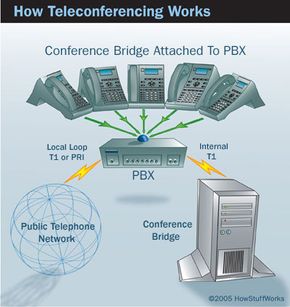If you've ever made a three-way phone call, you've already teleconferenced. When we talk about teleconferencing, we're referring to conference calls, where small to very large groups of people can participate in, or at least listen to, the same phone conversation.
There are two general types of conference calls. MeetMe conferencing requires participants to call a special phone number on a given day and time and enter an access code to join the teleconference. Ad-hoc conferencing requires a moderator to call each of the attendees individually and connect them together.
Conference calls require something called a conference bridge, a special server that can receive and route up to thousands of calls at the same time. Larger companies might own their own conference bridge, but it's also possible to subscribe to an outside company to host your conference calls on their bridge.
The conference bridge then links to a private branch exchange (PBX) within the company. A PBX is a miniature switch that routes calls to all the different internal phone extensions in the company. This is especially important for in-house conference calls.
A new teleconferencing option is VoIP conferencing, in which phone calls are made over the Internet rather than traditional phone lines. If a company already contracts with a VoIP service provider, it can usually upgrade to have teleconferencing capability. VoIP phone calls are considerably cheaper than traditional calls and with the right Internet connection speed are similar in quality.
There are many companies that host teleconferences and also offer helpful Web tools and in-call features. Here are some common features of teleconferencing services:
- Easy to e-mail or text message invitations to join the teleconference
- Call recording
- Audio control (mute or un-mute attendees)
- In-call operators
- Attendee polling
- Handset controls using the * key
Teleconferencing has endless applications in the business world, from large corporate conference calls for shareholder earnings reports to four salesmen in four different cubicles discussing a new product.
Teleconferencing's advantages are that the technology is familiar to anyone who uses a phone, it's easy to set up, and it offers good audio interactivity for small groups. Its disadvantages are that it greatly limits collaboration and interaction for larger groups, and that audio-only presentations are often less engaging to attendees.
Read on to learn about Web conferences and Web seminars.





